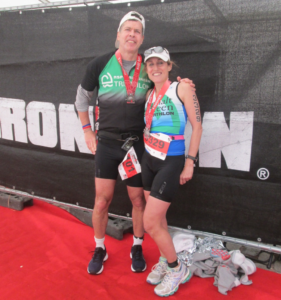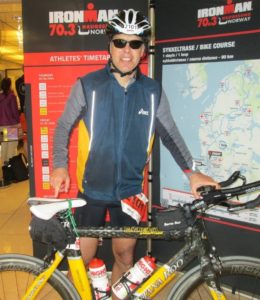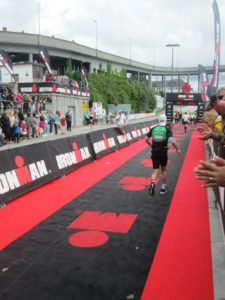I woke up on race morning with an extremely high blood sugar of 370 and noticed that, for the first time in my 16 years of living with Type 1 diabetes, my insulin pump tubing was not connected to my body. Was this a sign of things to come?
Little did I know how much I would learn about myself and other people that day.

David and Andrea at the Norway 70.3 Triathlon
Rewind to a year ago, when I convinced my wife Andrea that we travel to Norway to race in the Ironman Norway 70.3 (a triathlon consisting of a 1.2 mile swim, 56 mile bike and 13.1 mile run) and to wrap a vacation around it. In the six months leading to the race, we trained almost daily and planned the many logistics including renting bikes from the race director rather than shipping our bikes to Norway (more on that later).
I created my race day diabetes plan based on many trial and error experiences at similar races. The strategy was customized to the characteristics and course of the Ironman Norway 70.3 with food and insulin meticulously planned at 15 minute intervals over the more than six hours of projected race time. I typically eat over a thousand calories during this length race which raises my blood sugar, while the insulin and the exercise bring my blood sugar down. If my blood sugar goes high I become groggy and sluggish, and if it goes low I can get disoriented and pass out. The best thing I can do to avoid health problems and maximize athletic performance is to keep my blood sugar at the proper levels for a person with diabetes.
When we arrived in Haugesund, Norway, we learned that the weather in the region changes continually and that it can be winter, spring, summer and fall all in one day. The days transitioned through sun, torrential downpours and changing temperatures.
Some triathlon Vikings explained that they train on their bikes all year round through the rainy cold weather and only hang up their bikes when it snows. Memo to self: Get tough like the Vikings.
So, after learning about my disconnected pump on race morning, I took 6.5 units of insulin (more than four times the usual amount and equivalent to my eating four extra power bars to compensate under normal conditions and to avoid a low blood sugar during the race).

David at the Ironman Norway swim start
When we arrived at the swim start, the race director informed us that due to the water temperature dropping another two degrees Celsius to 15.5 degrees (59.5 degrees Fahrenheit) the swim was being shortened from 1900 meters to 1500 meters. Message to self: Get tough like the Vikings.
I ended up with a good swim and went out on the bike course. The scenery was beautiful with fjords surrounding the course. The weather kept changing from torrential downpours to sunshine. The bike course circled back through town, and I was riding over some cobblestones, when I heard noise behind me and saw that my bike seat had fallen off. With more than 20 miles to go this was not a good thing to say the least. Apparently the bike mechanic who put my seat, or “saddle,” on the rented bike hadn’t done it correctly. As reference, I have never seen anyone’s saddle come off of their bike ever. I salvaged the pieces, but without proper tools and parts, there was nothing I could do. Although a triathlete with diabetes who never gives up, all of my perseverance could not overcome this mechanical challenge. I ran with the bike for a while (not a viable solution in cleated bike shoes) until I bumped into two Norwegians who agreed to help me.

The bungee cord saddle solution
While not elegant, the solution was a bungee cord holding my saddle onto the bike. At that moment, I realized the incredible power of teamwork. These people had literally saved my race. I also realized that helping people overcome challenges doesn’t have to be time intensive; it can be only moments as long as it is valuable.
As I rode the last 20 miles of the bike course, I committed to use this learning in my life. I remembered the incredible satisfaction of working with the Juvenile Diabetes Research Foundation, helping support children with diabetes (and their families) by teaching them how to continue participating in school sports, activities, and normal life.
For the last eight years, I devoted my energies to building Cecelia Health, where we use technology to scale the support of Certified Diabetes Educators (CDEs) and partner with Pharmaceutical, Payer and ACO clients to improve the health of people with diabetes. The CDEs have become my proxy to helping tens of thousands of people per year. This model helps to reach many people in need and increases the moments when a child, or their family, realizes that they can participate in soccer practice after dinner (remember the challenges of high and low blood sugars) rather than not being on the team at all.
What had stopped me from working with the Juvenile Diabetes Research Foundation was that there never seemed to be enough time to keep doing this hands on work, while simultaneously balancing building a company, family, diabetes and the rest of life. I learned that day at the race that I can be effective with focused, valuable and relevant support. The few moments of creativity and attention required to solve the bike saddle challenge, with a bungee cord no less, changed my perspective forever. Now it is time to pass that learning forward.
So, I finished my bike ride up and down the Norwegian hills, in pain (try lowering your bike seat by several inches next time you ride) and with a huge smile.

Crossing the finish line!
I then ran a solid half marathon to finish the race in 7 hours and 8 minutes. While I had lost 30-40 minutes due to the bike challenges, what I gained was incomparable.
Tears of joy and gratitude flowed from my eyes after crossing the finish line. My perseverance complemented by teamwork got the job done that day.
I don’t yet know all of the details as to “how,” but I can’t wait to be on other people’s diabetes teams to help figure out together the “one thing” that can get them to finish their race.
By: David Weingard
David Weingard is a founder and CEO of Cecelia Health. He has completed hundreds of running and triathlon races and has competed with diabetes for the past 16 years.
